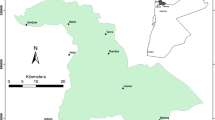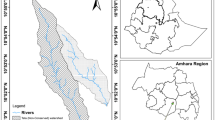Abstract
The development and utilization of water and land resources in the Shiyang River basin are the highest among the inland rivers in northwestern China. Using GIS and the landscape structure analysis program FRAGSTATS, landscape metrics of a study area in the lake-district in Minqin Oasis in the lower reaches of Shiyang River basin were calculated and analyzed based on TM images from 1987 to 2001 at class level and landscape level, respectively. Transformation matrix of the landscape mosaics was also examined. The driving forces of landscape changes were analyzed, including the dynamics of runoff and groundwater resources and their exploitation, and influences of policies and market economy. The results showed that: (1) Patch number of farmland and desert decreased, but their mean patch area increased, indicating that reclamation and desertification was very serious in the study area. Contagion index for oasis increased and edge density and landscape diversity were reduced. (2) Farmland and desert areas have enlarged by 1,520.46 and 4,941.27 hm2, respectively. This increase was at the cost of woodland and grassland, which shrank by 1,520.46 and 4,941.27 hm2, respectively. (3) The net utilization of surface water decreased by 50% in the last 10 years, and dropped to 22.3 × 106 m3 in the later 1990s. Exploitation of groundwater increased remarkably, up to 80 × 106 m3 per year in the last 5 years. (4) The capability of the economic structure to withstand pressures of the market economy has depressed distinctly because of the simplified planting pattern, which is dominated by salinity-enduring cash crops, such as cotton. Based on the above analysis, strategies of ecological reconstruction in the lake-district were suggested.






Similar content being viewed by others
References
Du JZ (2002) Investigating report about people’s poverty in Huqu of Minqin. Gansu Agric 10:20–23
Feng Q, Endo KN, Cheng GD (2001) Towards sustainable development of the environmentally degraded arid rivers of China: a case study from Tarim River. Environ Geol 41:29–238
Jia B, Zhang Z, Ci L, Ren Y, Pan B (2004) Oasis land-use dynamics and its influence on the oasis environment in Xinjiang, China. J Arid Environ 56:11–26
Li SM, Cheng GD, Li YH, Wang L (2002) Rational utilization of water resource and protection of ecological environment in the Hexi Corridor. Zhengzhou: Yellow River Water Conservancy Press. 72–94
Li X, Lu L, Cheng G, Xiao H (2001) Quantifying landscape structure of the Heihe River Basin, north-west China using FRAGSTATS. J Arid Environ 48:521–535
Li XY, Song DM, Xiao DN (2005) The Spatio-temporal variability of groundwater mineralization in Minqin oasis in lower reaches of Shiyang river. Acta Geogr Sin 60:319–327
Li XY, Xiao DN (2005) Dynamics of water resource and land use in oases in middle and lower reaches of Shiyang River watershed, Northwest China. Adv Water Sci 16:643–648
Lu L, Li X, Cheng G (2003) Landscape evolution in the middle Heihe River Basin of north-west China during the last decade. J Arid Environ 53:395–408
Ma JZ, Wang XS, Edmunds WM (2005) The characteristics of ground-water resources and their changes under the impacts of human activity in the arid Northwest China: a case study of the Shiyang River Basin. J Arid Environ 61:277–295
Shi PZ (2004) Studying on cotton irrigation by salt water in arid zone. J Irrig Drain 23:73–75
Shi Q, Chen FH, Zhu Y, David M (2002) Lake evolution of the terminal area of Shiyang River drainage in arid China since the last glaciation. Quatern Int 93:31–43
Shi YL (2003) Several suggestions on development and ecological protection in Hexi Region. Collect Land Sci 5:347–350
Song DM, Xiao DN, Zhang ZC (2004) Change of ecological security of Minqin oasis in Shiyang river basin. J Desert Res 24:335–342
Song DM, Xiao DN, Zhang ZC (2003) Landscape changes and driving force of the Minqin Oasis in Gansu Province. Chin J Appl Ecol 14:535–539
Tang QC, Zhang JB (2001) Water resources and eco-environment protection in the arid regions in Northwest of China. Prog Geogr 20:227–233
Wang G, Ding Y, Shen Y, Lai Y (2003) Environmental degradation in the Hexi Corridor region of China over the last 50 years and comprehensive mitigation and rehabilitation strategies. Environ Geol 44:68–77
Wang Q, Shi JA, Chen GJ, Xue LH (2002) Environmental effects induced by human activities in arid Shiyang River basin, Gansu province, northwest China. Environ Geol 43:219–227
Wang Q, Wang JH, Xu YH, Cui HM (2004) Analysis on water-saving irrigation and water effectiveness on Medicago sativa in arid desert oasis. J Desert Res 24:343–348
Xiao DN, Li XY, Song DM (2005) Landscape changes and ecological reconstruction in Minqin Huqu oasis. Acta Ecol Sin 25:2477–2483
Xiao DN, Zhong LS (1998) Ecological principles of landscape classification and assessment. Chin J Appl Ecol 9:217–221
Zhang H, Wu JW, Zheng QH, Yu YJ (2003) A preliminary study of oasis evolution in the Tarim Basin, Xinjiang, China. J Arid Environ 55:545–553
Zou YH, Wang YH (1999) Dynamic analysis of environment deterioration in lake area of Minqin by means of remote sensing and GIS. J Lanzhou Univ (Nat sci) 35:109–116
Acknowledgments
This study was financed by the National Natural Science Foundation of China, No. 40501068, No. 40501073, and No. 90102004 and the National Basic Research Program of China (973), No. 2002CB111506.
Author information
Authors and Affiliations
Corresponding author
Rights and permissions
About this article
Cite this article
Li, X., Xiao, D., He, X. et al. Evaluation of landscape changes and ecological degradation by GIS in arid regions: a case study of the terminal oasis of the Shiyang River, northwest China. Environ Geol 52, 947–956 (2007). https://doi.org/10.1007/s00254-006-0536-2
Received:
Accepted:
Published:
Issue Date:
DOI: https://doi.org/10.1007/s00254-006-0536-2




